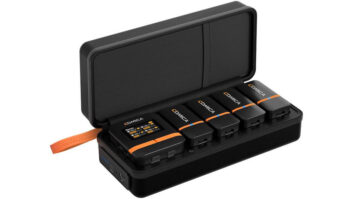Mating great microphones with robust diversity transmission is the formula for wireless success. The first product in a new series of wireless systems from AKG offers a broad range of solutions for budget-conscious applications. Available with either a handheld transmitter or a bodypack, plus a wide variety of mic elements, the WMS combines VHF frequency-agility with high performance at an attractive price.
The HT 60 handheld comes with AKG’s new D880 Emotion Series supercardioid dynamic capsule ($580 list). It is also available with one of three Tri-Power elements-the D3700 and D3800 dynamic or the C5900 condenser-as well as my favorite singer’s mic, the C535. These interchangeable screw-mount capsules can also be ordered separately, though they raise the system’s cost; for example, the 535 adds $270 to its list price. The PT 60 bodypack ($518 list when supplied with a guitar cable only) has a mini-XLR connector that will connect with a choice of AKG’s MicroMic collection, including the C417 lavalier, C419 clip-on, C420 headset and CK 77 lavalier.
The transmitters offer gain adjustment, frequency selection, a power switch and a mute switch, all hidden inside the microphone body or beltpack. A ring in the handheld transmitter can be changed for another that allows the unit to be muted without opening it, and an optional set of colored rings can be used to identify multiple transmitters.
Both handheld and bodypack transmitters are equipped with battery-status LEDs that momentarily glow brightly when first turned on to indicate they’re okay, and then they dim. They glow brightly again when battery life is under 90 minutes. Both transmitters use AA batteries, and, with over eight hours of use from a fresh set of alkaline batteries and ample warning, there’s little need to turn them off to conserve power over the course of a day.
The WMS 60 receiver employs the half-rackspace form-factor of most wireless products. Featuring a plastic chassis and an external power supply, the WMS 60 is a bit larger than a paperback and about the same weight. The AC adapter/ transformer is positioned in the middle of the eight-foot cable (provided), a design that makes better use of power strip input slots than a wall-wart; a clip on the receiver’s back holds the DC plug in place. Front panel controls include a power switch and recessed, screwdriver-adjustable pots for frequency selection, volume and squelch. A clip on the back of the unit keeps a screwdriver handy.
The receiver uses AKG’s new 4LD microprocessor-controlled diversity for rapid switching to find the strongest signal. Two pairs of front panel LEDs show diversity switching and RF signal strength. Other LEDs indicate audio signal present, and Peak and Mute modes. Two telescoping antennae are fixed to the front panel, and there are instructions for determining how many antenna segments to extend for optimum performance. Both balanced and unbalanced outputs are provided, and the XLR output can be switched from line to mic level. The receiver also comes with a rackmount kit. Unfilled knockouts on the back for BNC connectors suggest that this platform will also be used for other systems.
Both transmitter and receiver are labeled with a frequency chart for their 15-position selector. For the United States, there are two sets of “Traveler” frequencies between 169 and 172 MHz that each offer four frequencies, and two frequencies in each set can be used at once. For non-traveling U.S. applications, there are five more sets operating in TV bands 7, 8, 11 or 12, each with 15 frequencies, of which three can be used simultaneously in a single TV channel. Even with the advent of digital TV, one of these TV channels will be free in your city (except maybe San Francisco). Altogether, up to nine systems can be used in proximity without interference.
I used the Emotion capsule for a church’s musical service and discovered that the system was capable of high gain before feedback and created low handling noise. With a signal-to-noise ratio of 100 dB and a frequency response of 50 to 20k Hz, there is little to distinguish the wireless system from its hardwire-equivalent AKG capsule. Since I’m most familiar with the C535, I swapped capsules to make a comparison. The only noticeable difference was a subtle artifact of the compander on loud transients. I used the C417 lavalier on a violin for a Christmas pageant and was surprised by the smooth high-end response. Guitar players interested in sonic quality should check out this system’s performance.
Although I initially discounted this system as a music store product, the price and packaging undersell its performance. After careful listening, I would be hard-pressed to find better value in an inexpensive wireless system. As the RF world turns, VHF is not such a bad place to be, and the WMS 60 has some advantages to offer, including the benefits of frequency agility.
AKG Acoustics, 1449 Donelson Pike, Suite 12, Nashville, TN 37217; 615/360-0499. Web site: www.akg-acoustics.com.







